Laos

Welcome to Laos - where a 500 note is equal to 0.027 pence - here we are millionaires (e.g. we have £55).
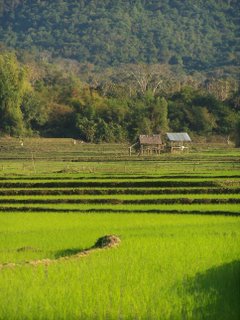
A (paddy) field. (Yes we have better photos than this that could be on the blog instead).
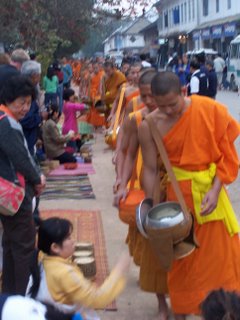
The buddhist monk procession - 7am every day in Luang Prabang. They recieve their rice in small dollops into their alms bowl - 900 monks from 66 temples in town, and lots of rice providers from tourists, locals, and even devoit buddhists. At the end of the line a few beggars who the monks give a little back to.
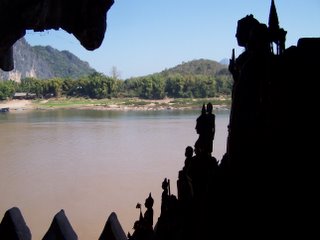
The Pak Ou caves (where all the old Buddhas went). Two hours slow boat up the Mekong from Luang Prabang.
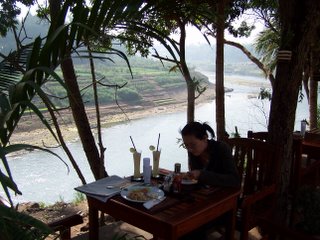
Enjoying breakfast (fried rice) the 'backpacker way' by the Nam Kham - Luang Prabang (Luang Prabang is at the confluence of the Nam Kham and Mekong).
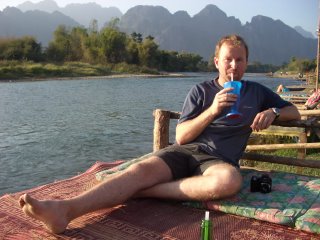
Just one more mango shake (on the river at Vang Vieng)
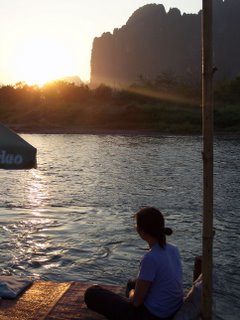
Sunset (another one) - Vang Vieng
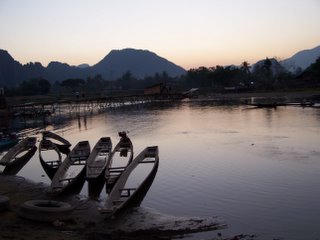
Attempted arty - the Nam Song (Vang Vieng) at dusk.
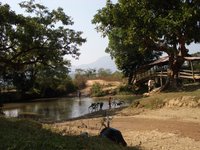 Testing the water depth
Testing the water depth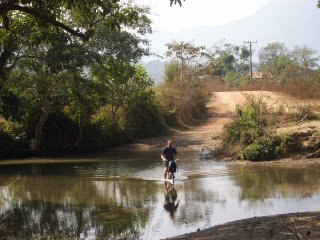
Then hurrah, 20p bridge toll avoided (riding to caves in Vang Vieng).
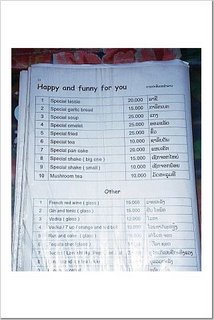
One of many menus in Vang Vieng 'Happy and funny for you' - Happy Shakes, Mushroom pizzas, Opium Tea etc.
In my view Laos has two obvious problems - both of which would be resolved were the Lao authorities to refuse entry to the French.
This solution to my problems - too many tourists concentrated on Laos's three most convenient (but relatively small) attractions, and then additionally too many of them being French (there are loads of them here) - probably wouldn't help the actual problem Laos faces - which is that it's a very poor nation.
Laos being a very poor nation is also however, in my current prejudiced view, the fault of the French. Had the French not colonized Laos, the Pathet Lao (literally 'free Lao') wouldn't have felt the need to join the Viet Minh (communists) opposed to France in Vietnam. The Viet Minh wouldn't have then invaded Laos to defeat the French and hand the land to the Pathet Lao. Laos wouldn't now be a communist state and it wouldn't have tried the disastrous social experiment of accelerated socialism and collectivisation which forced the countries educated and wealthy to flee to escape "re-education camps". With the benefit of these people still in Laos the country would be prosperous and happy. Also they may not now drive on the right, they wouldn't occasionally munch on "French sticks" at lunch and they'd live in a country called Lao (the French renamed it).
Anyway - the three main attractions (mentioned above) where every tourist to Laos will surely visit are Vientiene (the sleepy capital), Vang Vieng (backpackers playground) and Luang Prabang (faded colonial (now UNESCO) town meets Buddhist monk schools).
Being free thinking and independent travellers, our itinerary (not really geared around alleviating the problem of concentration of tourists) was Vientiene, Vang Vieng, Luang Prabang ... then back to Vang Vieng and back to Vientiene (for flights to Hanoi) - our plans would be a lot more exciting (and less expensive) had our 2004 guide book told us a useful Lao / Vietnamese border crossing had opened to westerns in 2004 (damnit).
When we arrived in Laos it was to Vientiane. Most of the streets are paved, most of the people are awake. There's not a great deal in terms of attractions, though it has a pleasant feel. There's a vague Arc de Triomphe lookalike (built in the 60's using cement purchased by the US in order to build a new airport). Beside it the Lao tourist board have an informative sign reading "from a closer distance, it appears even less impressive, like a monster of concrete".
Vientiene sits on the Mekong .. the tenth longest river in the world at 2,600 miles - starting in Tibet and flowing through China it then forms the border for Laos with Myanmar then Laos with part of Thailand. It flows on into Cambodia and then into the South China Sea via vast deltas in Vietnam (large portions of it aren't navigable though).
The river running through Vang Vieng is the Nam Song - a gentle and serene river in the dry season. Vang Vieng has a population of 25,000 ish and the backpacker contingent (in the old centre) is not therefore very discreet (in fact there's a 'locals' Vang Vieng about two kilometres north of the old centre - presumably as the old centre became too expensive and full of strange farangs). Described as another "backpacker haven" the draw is primarily the scenery, with large limestone cliffs rising sheer from the fields surrounding town. To supplement this there are "must do" activities - floating 10km down the rivers' gentle rapids on an inner tube, visiting numerous large caves by bike and relaxing on bamboo platforms for two (built next to and in the river) lying on mattresses drinking fruit shakes (or, also on the menu, countless 'happy' shakes, 'mushroom' pizzas etc)
Being of a boring and sensible disposition we didn't try the happy stuff for some spacey or paranoid hallucinogenic fun (not even when briefly 'checking out' a full moon party) but we did ponder for a moment or two. Later that night as we were reading peacefully in bed (75 pence each) there was a large crash as a cat fell through our ceiling, via the fan, to the floor (we let it out apparently unhurt). Two minutes later we let out an enormous flying bug. We pondered what we'd have made of these events had we first indulged in some mushroom soup!
So we didn't get doped up for 20,000 kip (just over a pound), but the bikes, caves and inner tube were ticked. Floating downstream there's a series of elaborate 'mad max' style constructions made from bamboo and rising (random made up amount) up to 15 feet into the air. Although moments earlier we'd had to push ourselves along having been grounded - we were told what fun it is to jump (swing, cable slide) off these platforms. I did - but only after those providing the peer pressure had done so themselves.
So Vang Vieng would be ideal place ... but for the overpopulation of backpackers and subsequent explosion of 'western' restaurants.
Showing the soles of your feet is rude, taking shoes (flip flops) off indoors is polite, dressing modestly is expected, westerners flashing wealth is just generally not a good thing to do. In Vang Vieng the westerns, wearing just shorts (maybe also bikini tops for some) and flip flops, sitting at a restaurant table indoors, perhaps with a friend resting his bare feet on the table while looking at pictures on each others massive and expensive cameras. Arh, respect for the locals. The (intrusive) pictures almost certainly would be of 'characterful' old faces, children playing in the river, or 'discreet' shots of monks walking by.
The backpackers who've been travelling around for a while may be slightly tuned into more diplomatic practises - but many of the offenders appeared pasty white and carried suitcases with luggage labels still attached. On closer inspection the luggage labels read 'Airfrance'.
The French colonisation of Lao wasn't glorious. They gave away a large portion of Lao to Siam (just after the Lao boundaries had been agreed between China, Britain and Siam). They weakened interstate relations, stifled modernisation (by imposing a Vietnamese staffed civil service which is still an issue today), and disregarded historic dividing lines (so as soon as they left there was a civil war).
Nevertheless the French seem to believe they have certain affinity with the place, and nowhere more so than Luang Prabang. The main street is lined with restaurants - some of which have French sounding names and French sounding food (a little too pricey for us); most also sold a standard fare of noodles, rice and 'Morning Glory' (a weed that grows in the rivers). There are baguettes galore and even some fine wines. Unfortunately (for the French) the menus are all in English. (Currently in Asia there are 1.1 million people learning French - which represents a teaching rate of 0.2%).
In Luang Prabang we visited the Tat Kuang Si waterfall as well as taking a slow boat up the Mekong to the Pak Ou caves (crammed full of (tichy tiny) Buddhas) as well as an awful lot of aimlessly wandering around and drinking copious Mango Shakes.
The people here are very relaxed and their hard sell disintegrates into genuine and pleasant smiles when they're smiled at. Some monks started talking to us (to practise their English). We were terrified of saying something inappropriate about their way of life - so didn't ask all the questions we actually wanted to. They'd been studying for six years and were perhaps in their late teens. One of them wanted to teach English, his other ambition was to see a tall building. We got the impression he was a monk primarily because of the free food and lodgings.
So finally for Laos - and before we push off for Hanoi - a potted history for interest....
In 1858 the French launched a naval expedition to punish the Vietnamese for killing missionaries. In 1861 they controlled south Vietnam, and then the North too in 1885 after the Sino-French War (against the Chinese who wanted the North). In 1887 Cambodia was a part of the French holdings in Vietnam which now was called French Indochina. In 1893 Laos was added and became a backwater of Indochina until the second world war. Under agreement with the French, Japan stationed troops in Indochina. Surprisingly the Japanese then seized control of Indochina and interned French officials and troops. They then granted Laos nominal independence in 1945.
An independent government was established for a year, before the French came back and the government fled to Thailand. In 1949 an amnesty was offered to these exiled nationalists (the Pathet Lao) - who returned and promptly joined forces with the Viet Minh (pro communists fighting France in Vietnam). In 1953 the Viet Minh invaded Laos, 'giving' the land to the Pathet Lao. The French ceded full independence in the same year to Laos as a constitutional monarchy (and also withdraw from Indochina in 1954 following the unsuccessful end of the First Indochina War).
A coalition government was established in 1957 between communist and non-communist groups in Laos. In stepped the United States who were opposed to all things communist and gave heavy support to an anti-communist group - enough support that they were able to rig the next election and oust the communist element. Thus followed a renewal of guerrilla warfare.
As the war in Vietnam escalated, Laos became important to both North Vietnam and the US. Both sides violated the neutrality of Laos - the North Vietnamese by infiltrating troops and supplies down the Ho Chi Minh Trail through eastern and southern Laos, and the US by secretly bombing the trail (quite a hard secret to keep you'd think) and by recruiting, financing, and training a mercenary forces. A secret airforce - Air America - made up of US military in civilian clothes and obsolete aircraft (and suffering up to a 50% casualty rate) dropped an average of one planeload of bombs every eight minutes, 24 hours a day for nine years. By 1973 that was over half a tonne of ordnance for everyone in Laos (making it the most heavily bombed nation, per capita, in the world).
With the end of the Vietnamese war the communist factions gained ground, and in 1975 they forced the king to abdicate and proclaimed the Lao People’s Democratic Republic (modeled on other Communist states). In 1986, after several years of a failing communist model, Laos decided to liberalize the economy and allow foreign investment and an open-market economy.
Bet no-one knew that much about Laos before!?
